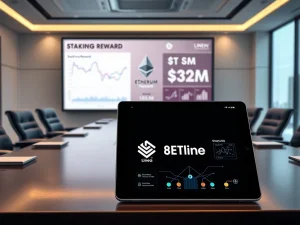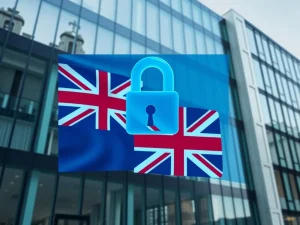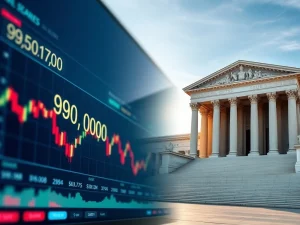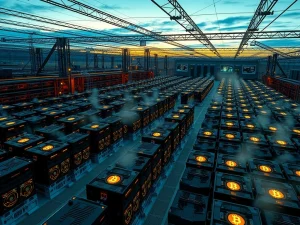XRP Ledger: Unlocking a Revolutionary $130M in Brazil’s Tokenized Agribusiness Assets
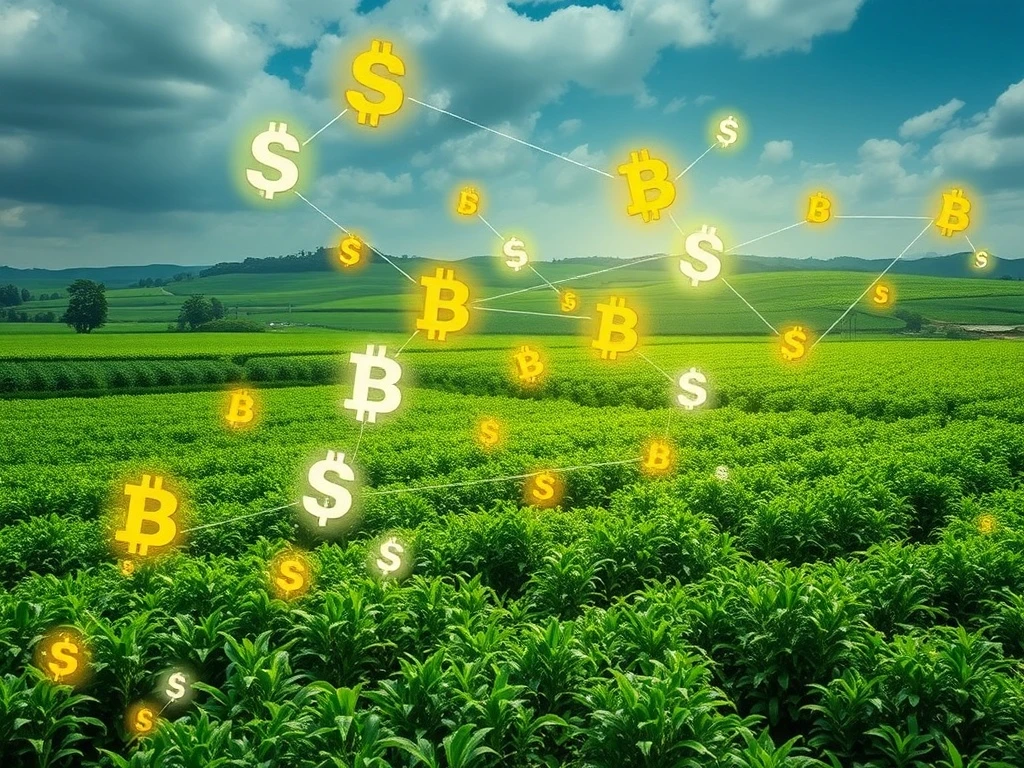
The world of finance is rapidly evolving, and at the forefront of this transformation is the XRP Ledger, proving its mettle beyond just cryptocurrency transactions. Imagine a future where traditional assets are seamlessly digitized, opening up unprecedented opportunities for investors and businesses alike. This vision is now becoming a reality in Brazil, thanks to a groundbreaking initiative leveraging the power of XRP.
How is the XRP Ledger Revolutionizing Brazil’s Agribusiness?
At the heart of this innovation is the XRP Ledger (XRPL), chosen by fintech firm VERT to modernize Brazil’s capital markets. VERT has successfully launched a blockchain-based platform to tokenize a significant $130 million Agribusiness Receivables Certificate (CRA) in Brazil. This isn’t just a one-off project; it’s the pilot phase of an ambitious $500 million expansion pipeline, aiming to revolutionize tokenized private credit workflows.
The XRPL’s inherent capabilities—its speed, security, and transparent record-keeping—are pivotal. Transactions are recorded on the ledger, enhancing clarity and reducing the time lag between execution and record-keeping. Furthermore, the integration of the XRPL EVM Sidechain enables Ethereum-compatible smart contract functionality, automating reporting and streamlining operations, a crucial step for complex financial instruments.
Gabriel Braga, VERT’s Director of Digital Assets, highlighted the platform’s ability to capture operational events in granular detail, significantly reducing latency. Ripple’s Managing Director for LATAM, Silvio Pegado, emphasized the broader economic potential, seeing the XRP Ledger as a foundational infrastructure for national growth through digitized financial systems.
What Are Tokenized Assets and How Do They Unlock New Investment Frontiers?
What exactly are these tokenized assets? In this context, they are digital representations of real-world assets—specifically, cash flows tied to agricultural production. By converting these traditional assets into digital tokens on the XRPL, VERT is enabling fractional ownership, democratizing access for a wider range of investors.
This innovation is a game-changer for private credit markets, which often suffer from illiquidity. Tokenized assets bridge this gap by offering potential for secondary market liquidity, attracting institutional interest seeking diversified yield sources. The platform’s technical architecture also supports efficient cross-border transactions, a critical factor given the global nature of capital markets, with low fees and high throughput.
How is Blockchain Finance Reshaping Global Capital Markets?
VERT’s strategy perfectly aligns with the burgeoning trend of blockchain finance. This initiative demonstrates how distributed ledger technology can reshape traditional asset classes through programmability and interoperability. The XRP Ledger, with its unique architecture, offers a compelling alternative to older proof-of-work blockchains.
Its deterministic finality—confirming transactions in just four seconds—is a significant advantage over traditional settlement systems that can take days. This speed, combined with its balance of decentralization and compliance tools like transaction traceability, positions the XRPL as a robust foundation for modern blockchain finance applications, addressing concerns about energy consumption and governance.
Are Digital Assets the Future of Private Credit?
The tokenization of private credit via digital assets represents a significant step forward. While the $130 million CRA in Brazil is a pilot, the $500 million pipeline signals a strong commitment to expanding this model to other asset classes and emerging markets. This move is attracting substantial institutional interest, as it offers a novel way to access previously illiquid private credit assets.
However, the path forward isn’t without its hurdles. Challenges such as regulatory uncertainty across different jurisdictions and the need for standardized frameworks persist. While VERT has secured partnerships with Brazilian banks and credit platforms, scaling the $500 million pipeline will require careful navigation of diverse regulatory environments. A key factor influencing investor confidence and secondary market liquidity will be how these digital assets are traded after issuance, a detail yet to be fully disclosed by the firm.
Why is Brazil Agribusiness Setting a Global Precedent for Tokenization?
Brazil’s robust agribusiness sector provides an ideal testing ground for this innovative approach. The issuance of the BRL 700 million ($130 million) CRA establishes a precedent for near real-time traceability in credit markets, setting a new standard for efficiency and transparency.
This successful pilot in Brazil agribusiness validates the technical feasibility of tokenized private credit. Its success hinges on continued market adoption and consistent returns, which could pave the way for similar initiatives in other key economic sectors globally. This project showcases blockchain’s potential to disrupt traditional lending paradigms and serves as a powerful case study for capital market modernization.
Summary
In conclusion, VERT’s pioneering initiative leveraging the XRP Ledger to tokenize Brazilian agribusiness receivables is more than just a technological feat; it’s a testament to the transformative power of blockchain in finance. By enhancing transparency, speed, and liquidity for traditional assets, this project not only modernizes Brazil’s capital markets but also sets a compelling precedent for the future of tokenized finance worldwide. As the $500 million pipeline unfolds, the world will be watching to see how this innovation unlocks new investment opportunities and reshapes the global financial landscape.
Frequently Asked Questions (FAQs)
1. What is an Agribusiness Receivables Certificate (CRA)?
An Agribusiness Receivables Certificate (CRA) is a security issued by financial institutions in Brazil, backed by credit rights related to agricultural activities. It’s a way for agribusinesses to raise funds and for investors to gain exposure to the agricultural sector.
2. How does the XRP Ledger enhance this tokenization process?
The XRP Ledger (XRPL) provides a fast, secure, and transparent blockchain platform for recording transactions. Its deterministic finality (transactions confirmed in 4 seconds) and low fees make it ideal for digitizing and managing financial instruments like CRAs, enhancing efficiency and reducing operational latency.
3. What are the benefits of tokenizing traditional assets like CRAs?
Tokenization offers several benefits, including fractional ownership, which democratizes access for a broader range of investors; enhanced liquidity through potential secondary markets; increased transparency and traceability of assets; and faster, more efficient settlement compared to traditional systems.
4. What challenges does VERT face in scaling this project?
Scaling the $500 million pipeline involves navigating regulatory uncertainties across different jurisdictions and establishing standardized frameworks for tokenized assets. Additionally, VERT needs to detail the post-issuance trading mechanisms for these tokenized assets to ensure investor confidence and secondary market liquidity.
5. How does this initiative impact XRP itself?
While this project directly utilizes the XRP Ledger for its technological capabilities (speed, security, transparency), it primarily focuses on tokenizing real-world assets rather than directly using the XRP cryptocurrency for settlement. However, such large-scale enterprise adoption of the XRPL reinforces its utility and could indirectly contribute to the broader ecosystem’s growth and perception.
6. Is this model applicable to other industries?
Absolutely. The model of tokenizing illiquid assets and private credit, as demonstrated by VERT in Brazil’s agribusiness, has vast potential for application in other industries. This includes real estate, art, intellectual property, and various forms of private equity or debt, paving the way for a more liquid and accessible global financial market.






